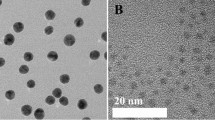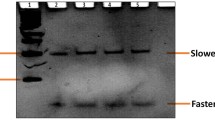Abstract
Kanamycin fluorescence aptasensors were created using a series of di-block oligonucleotide modified gold nanoparticles with various lengths of poly-adenine. In the presence of kanamycin, the double strand structure of the aptamer-reporter strand complex is disrupted, and the dye-labelled reporter strand detaches from the surface of gold nanoparticles, resulting in fluorescence recovery (Ex/Em = 485/520 nm). By adjusting the number of consecutive adenines, the programable aptamer density can be implemented on the gold nanoparticle surface, and the conformation of nucleic acid changed from lying-down to up-right. The apparent binding constant, binding kinetics, and limit of detection of the prepared aptasensors were carefully examined to explore the influence of surface density. Under the optimum condition, the aptasensor had a tenfold lower limit of detection than the thiolated aptamer modified one, as low as 23.6 nM, when a di-block oligonucleotide with twenty consecutive adenines tailed. In addition, satisfactory recoveries ranging from 96.33 to 99.47% were achieved in spiked milk samples with relative standard deviation of 1.2–6.9% (n = 3). This surface density regulation strategy holds great promise in other aptamer-based interfacial recognition and sensing.
Graphical abstract
Schematic presentation of di-block oligonucleotide modified gold nanoparticle with different surface densities and its kanamycin sensing application.







Similar content being viewed by others
References
Shao Y, Wang Y, Yuan Y, Xie Y (2021) A systematic review on antibiotics misuse in livestock and aquaculture and regulation implications in China. Sci Total Environ 798:149205. https://doi.org/10.1016/j.scitotenv.2021.149205
Wang H, Wang N, Qian J, Hu L, Huang P, Su M, Yu X, Fu C, Jiang F, Zhao Q, Zhou Y, Lin H, He G, Chen Y, Jiang Q (2017) Urinary antibiotics of pregnant women in Eastern China and cumulative health risk assessment. Environ Sci Technol 51(6):3518–3525. https://doi.org/10.1021/acs.est.6b06474
Dawadi S, Thapa R, Modi B, Bhandari S, Timilsina AP, Yadav RP, Aryal B, Gautam S, Sharma P, Thapa BB, Aryal N, Aryal S, Regmi BP, Parajuli N (2021) Technological advancements for the detection of antibiotics in food products. Processes 9(9):1500. https://doi.org/10.3390/pr9091500
Yang T, Duncan TV (2021) Challenges and potential solutions for nanosensors intended for use with foods. Nat Nanotechnol 16(3):251–265. https://doi.org/10.1038/s41565-021-00867-7
Xie M, Zhao F, Zhang Y, Xiong Y, Han S (2022) Recent advances in aptamer-based optical and electrochemical biosensors for detection of pesticides and veterinary drugs. Food Control 131:108399. https://doi.org/10.1016/j.foodcont.2021.108399
Wang S, Yan X, Yang Y, Qi X, Zhao Y, Li L, Ma R, Wang L, Dong Y, Sun J, Mao X (2021) Advances and perspectives of aptasensors for the detection of tetracyclines: a class of model compounds of food analysis. Food Chem 364:130361. https://doi.org/10.1016/j.foodchem.2021.130361
Yang P, Li Y, Mason SD, Chen F, Chen J, Zhou R, Liu J, Hou X, Li F (2020) Concentric DNA amplifier that streamlines in-solution biorecognition and on-particle biocatalysis. Anal Chem 92(4):3220–3227. https://doi.org/10.1021/acs.analchem.9b04964
Yang P, Zhou R, Kong C, Fan L, Dong C, Chen J, Hou X, Li F (2021) Stimuli-responsive three-dimensional DNA nanomachines engineered by controlling dynamic interactions at biomolecule-nanoparticle interfaces. ACS Nano 15(10):16870–16877. https://doi.org/10.1021/acsnano.1c07598
Jacobson DR, McIntosh DB, Stevens MJ, Rubinstein M, Saleh OA (2017) Single-stranded nucleic acid elasticity arises from internal electrostatic tension. Proc Natl Acad Sci USA 114(20):5095–5100. https://doi.org/10.1073/pnas.1701132114
Watkins HM, Simon AJ, Ricci F, Plaxco KW (2014) Effects of crowding on the stability of a surface-tethered biopolymer: an experimental study of folding in a highly crowded regime. J Am Chem Soc 136(25):8923–8927. https://doi.org/10.1021/ja411486g
Yang F, Zuo XL, Fan CH, Zhang XE (2018) Biomacromolecular nanostructures-based interfacial engineering: from precise assembly to precision biosensing. Natl Sci Rev 5(5):740–755. https://doi.org/10.1093/nsr/nwx134
MacDonald H, Bonnet H, Van der Heyden A, Defrancq E, Spinelli N, Coche-Guerente L, Dejeu J (2019) Influence of aptamer surface coverage on small target recognition: a SPR and QCM-D comparative study. J Phys Chem C 123(22):13561–13568. https://doi.org/10.1021/acs.jpcc.9b00845
Balamurugan S, Obubuafo A, McCarley RL, Soper SA, Spivak DA (2008) Effect of linker structure on surface density of aptamer monolayers and their corresponding protein binding efficiency. Anal Chem 80(24):9630–9634. https://doi.org/10.1021/ac8009559
Song Y, Song W, Lan X, Cai W, Jiang D (2021) Spherical nucleic acids: organized nucleotide aggregates as versatile nanomedicine. Aggregate n/a (n/a):e120. https://doi.org/10.1002/agt2.120
Cutler JI, Auyeung E, Mirkin CA (2012) Spherical nucleic acids. J Am Chem Soc 134(3):1376–1391. https://doi.org/10.1021/ja209351u
Fong LK, Wang Z, Schatz GC, Luijten E, Mirkin CA (2018) The role of structural enthalpy in spherical nucleic acid hybridization. J Am Chem Soc 140(20):6226–6230. https://doi.org/10.1021/jacs.8b03459
Liu BW, Liu JW (2019) Interface-driven hybrid materials based on DNA-functionalized gold nanoparticles. Matter 1(4):825–847. https://doi.org/10.1016/j.matt.2019.08.008
Pei H, Li F, Wan Y, Wei M, Liu H, Su Y, Chen N, Huang Q, Fan C (2012) Designed diblock oligonucleotide for the synthesis of spatially isolated and highly hybridizable functionalization of DNA-gold nanoparticle nanoconjugates. J Am Chem Soc 134(29):11876–11879. https://doi.org/10.1021/ja304118z
Yao G, Li J, Li Q, Chen X, Liu X, Wang F, Qu Z, Ge Z, Narayanan RP, Williams D, Pei H, Zuo X, Wang L, Yan H, Feringa BL, Fan C (2020) Programming nanoparticle valence bonds with single-stranded DNA encoders. Nat Mater 19(7):781–788. https://doi.org/10.1038/s41563-019-0549-3
Chen XL, Liu XG, Yao GB, Li Q, Liu RD, Wu HJ, Lv YN, Fan CH, Wang LH, Li J (2020) PolyA-based DNA bonds with programmable bond length and bond energy. Npg Asia Materials 12(1):49. https://doi.org/10.1038/s41427-020-0231-x
Chen L, Chao J, Qu X, Zhang H, Zhu D, Su S, Aldalbahi A, Wang L, Pei H (2017) Probing cellular molecules with polyA-based engineered aptamer nanobeacon. ACS Appl Mater Interfaces 9(9):8014–8020. https://doi.org/10.1021/acsami.6b16764
Wang L, Zhang H, Wang C, Xu Y, Su J, Wang X, Liu X, Feng D, Wang L, Zuo X, Shi J, Ge Z, Fan C, Mi X (2019) Poly-adenine-mediated spherical nucleic acids for strand displacement-based DNA/RNA detection. Biosens Bioelectron 127:85–91. https://doi.org/10.1016/j.bios.2018.12.003
Zhang X, Liu S, Song X, Wang H, Wang J, Wang Y, Huang J, Yu J (2019) Robust and universal SERS sensing platform for multiplexed detection of Alzheimer’s disease core biomarkers using PAapt-AuNPs conjugates. ACS Sens 4(8):2140–2149. https://doi.org/10.1021/acssensors.9b00974
Jiao K, Yan Q, Guo L, Qu Z, Cao S, Chen X, Li Q, Zhu Y, Li J, Wang L, Fan C, Wang F (2021) Poly-adenine-based spherical nucleic acids for efficient live-cell microRNA capture. Angew Chem Int Ed 60(26):14438–14445. https://doi.org/10.1002/anie.202017039
Nutiu R, Li Y (2003) Structure-switching signaling aptamers. J Am Chem Soc 125(16):4771–4778. https://doi.org/10.1021/ja028962o
Li X, Zhang J, Gu H (2012) Study on the adsorption mechanism of DNA with mesoporous silica nanoparticles in aqueous solution. Langmuir 28(5):2827–2834. https://doi.org/10.1021/la204443j
Yao GB, Pei H, Li J, Zhao Y, Zhu D, Zhang YN, Lin YF, Huang Q, Fan CH (2015) Clicking DNA to gold nanoparticles: poly-adenine-mediated formation of monovalent DNA-gold nanoparticle conjugates with nearly quantitative yield. Npg Asia Materials 7(1):e159–e159. https://doi.org/10.1038/am.2014.131
Song KM, Cho M, Jo H, Min K, Jeon SH, Kim T, Han MS, Ku JK, Ban C (2011) Gold nanoparticle-based colorimetric detection of kanamycin using a DNA aptamer. Anal Biochem 415(2):175–181. https://doi.org/10.1016/j.ab.2011.04.007
Long GL, Winefordner JD (1983) Limit of detection. A closer look at the IUPAC definition. Anal Chem 55 (7):712A-724A
Wang Y, Ma T, Ma S, Liu Y, Tian Y, Wang R, Jiang Y, Hou D, Wang J (2017) Fluorometric determination of the antibiotic kanamycin by aptamer-induced FRET quenching and recovery between MoS2 nanosheets and carbon dots. Microchim Acta 184(1):203–210. https://doi.org/10.1007/s00604-016-2011-4
Liu R, Yang Z, Guo Q, Zhao J, Ma J, Kang Q, Tang Y, Xue Y, Lou X, He M (2015) Signaling-probe displacement electrochemical aptamer-based sensor (SD-EAB) for detection of nanomolar kanamycin A. Electrochim Acta 182:516–523. https://doi.org/10.1016/j.electacta.2015.09.140
Tang Y, Hu Y, Zhou P, Wang C, Tao H, Wu Y (2021) Colorimetric detection of kanamycin residue in foods based on the aptamer-enhanced peroxidase-mimicking activity of layered WS2 nanosheets. J Agric Food Chem 69(9):2884–2893. https://doi.org/10.1021/acs.jafc.1c00925
Wang B-B, Zhao X, Chen L-J, Yang C, Yan X-P (2021) Functionalized persistent luminescence nanoparticle-based aptasensor for autofluorescence-free determination of kanamycin in food samples. Anal Chem. https://doi.org/10.1021/acs.analchem.0c04648
Wang H, Zhang C, An X, Li G, Ye B, Zou L (2021) Signal-off photoelectrochemical aptasensor for kanamycin: strand displacement reaction combines p-n competition. Anal Chim Acta 1181:338927. https://doi.org/10.1016/j.aca.2021.338927
Qi X, Zhao Y, Su H, Wang L, Li L, Ma R, Yan X, Sun J, Wang S, Mao X (2022) A label-free colorimetric aptasensor based on split aptamers-chitosan oligosaccharide-AuNPs nanocomposites for sensitive and selective detection of kanamycin. Talanta 238:123032. https://doi.org/10.1016/j.talanta.2021.123032
Acknowledgements
We thank the staff members of Electron Microscopy System and Large-scale Protein Preparation System at the National Facility for Protein Science in Shanghai (NFPS), Zhangjiang Lab, China, for providing technical support and assistance in data collection and analysis.
Funding
This work was financially supported by the National Natural Science Foundation of China (32172303 and 31801636).
Author information
Authors and Affiliations
Corresponding author
Ethics declarations
Competing interests
The authors declare no competing interests.
Additional information
Publisher's note
Springer Nature remains neutral with regard to jurisdictional claims in published maps and institutional affiliations.
Supplementary Information
Below is the link to the electronic supplementary material.
Rights and permissions
About this article
Cite this article
Ye, T., Zhu, D., Hao, L. et al. Poly-adenine-mediated spherical nucleic acids for interfacial recognition of kanamycin. Microchim Acta 189, 151 (2022). https://doi.org/10.1007/s00604-022-05235-3
Received:
Accepted:
Published:
DOI: https://doi.org/10.1007/s00604-022-05235-3




